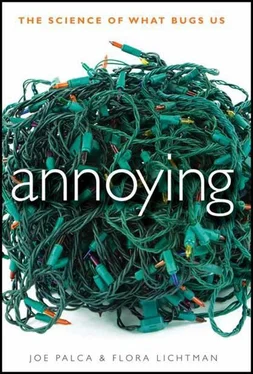2. Eric Block, Garlic and Other Alliums: The Lore and the Science (Cambridge, UK: Royal Society of Chemistry), 2009.
3. Rachel Herz, The Scent of Desire: Discovering Our Enigmatic Sense of Smell (New York: HarperCollins), 2007.
4. Rachel S. Herz and Julia von Clef, “The Influence of Verbal Labeling on the Perception of Odors: Evidence for Olfactory Illusions?” Perception 30(3) (2001): 381–391.
5. Paul Krebaum, “Lab Method Deodorizes a Skunk-Afflicted Pet,” Chemical & Engineering News 71(42) (1993): 90.
6. The recipe and directions can be found at http://home.earthlink.net/~skunkremedy/home/.
1. Daniel J. Simons and Christopher F. Chabris, “Gorillas in Our Midst: Sustained Inattentional Blindness for Dynamic Events,” Perception 28 (1999): 1059–1074.
2. Entomological Society of America, “Frequently Asked Questions on Entomology,” http://www.entsoc.org/resources/faq#triv4.
3. Charles Darwin, On the Origin of Species (London: John Murray), 1859.
4. Francesco Facchinetti, “Sarà un campionato super, parola nostra,” Sorrisi e Canzoni , August 24, 2007, http://archivio.sorrisi.com/sorrisi/personaggi/art023001038259.jsp.
5. Diego Torres, “El fútbol empieza en la calle,” El Pais , March 1, 2010, http://www.elpais.com/articulo/deportes/futbol/empieza/calle/elpepidep/20100301elpepidep_18/Tes.
1. “A Possible Mendelian Explanation for a Type of Inheritance Apparently Non-Mendelian in Nature,” Science 40 (December 18, 1914): 904–906.
1. Pantelis Vassilakis, “Perspectives in Systematic Musicology: Auditory Roughness as a Means of Musical Expression,” Selected Reports in Ethnomusicology 12 (2005): 119–144.
2. J. P. Van de Geer, W. J. M. Levelt, and R. Plomp, “The Connotation of Musical Consonance,” Acta Psychologica 20 (1962): 308–319.
3. Thomas Fritz, Sebastian Jentschke, Nathalie Gosselin, et al., “Universal Recognition of Three Basic Emotions in Music.” Current Biology 19(7) (2009): 573–576.
1. Sarah F. Brosnan and Frans B. M. de Waal, “Monkeys Reject Unequal Pay,” Nature 425 (September 18, 2003): 297–299.
2. O. L. Tinklepaugh, “An Experimental Study of Representative Factors in Monkeys,” Journal of Comparative Psychology 8(3) (1928): 197–236.
3. Sarah Brookhart, personal communication with the author.
1. D. Felmlee, “From Appealing to Appalling: Disenchantment with a Romantic Partner,” Sociological Perspectives 44(3) (2001): 263–280.
2. R. S. Miller, “We Always Hurt the Ones We Love: Aversive Interactions in Close Relationships,” in R. M. Kowalski, ed., Aversive Interpersonal Behaviors (New York: Plenum Press, 1997), 11–29, esp. p. 19.
1. Catherine Lutz, Unnatural Emotions: Everyday Sentiments on a Micronesian Atoll and Their Challenge to Western Theory (Chicago: University of Chicago Press, 1988), 82.
2. Reuters Life! “Quiet Please! Noise Irks Japan’s Commuters the Most,” January 15, 2010, http://in.reuters.com/article/idINIndia-45415320100115.
3. Michael Ross and Qi Wang, “Why We Remember and What We Remember: Culture and Autobiographical Memory,” Perspectives on Psychological Science 5 (2010): 401.
4. Robert V. Levine, A Geography of Time: On Tempo, Culture, and the Pace of Life (New York: Basic Books, 1997), 5.
5. Ibid., 6.
6. Edward T. Hall, The Hidden Dimension (New York: Anchor Books, 1966).
1. Camille L. Julien, Jennifer C. Thompson, Sue Wild, et al., “Psychiatric Disorders in Preclinical Huntington’s Disease,” Journal of Neurology, Neurosurgery, and Psychiatry 78 (2007): 939–943.
2. J. S. Snowden, Z. C. Gibbons, A. Blackshaw, et al., “Social Cognition in Frontotemporal Dementia and Huntington’s Disease,” Neuropsychologia 41(6) (2003): 688–701.
3. J. S. Snowden, N. A. Austin, S. Sembi, J. C. Thompson, D. Craufurd, and D. Neary “Emotion Recognition in Huntington’s Disease and Frontotemporal Dementia.” Neuropsychologia 46(11) (September 2008): 2638–2649.
4. S. Klöppel, C. M. Stonnington, P. Petrovic, et al., “Irritability in Pre-Clinical Huntington’s Disease.” Neuropsychologia 48(2) (January 2010): 549–557.
1. Dana and David Dornslife, Cognitive Neuroscience Imaging Center, http://brainimaging.usc.edu/index.php?topic=forsubjects.
2. R. A. Cohen, R. Paul, T. M. Zawacki, D. J. Moser, L. Sweet, and H. Wilkinson, “Emotional and Personality Changes following Cingulotomy,” Emotion 1 (2001): 38–50.
1. Larry J. Young, “Being Human: Love: Neuroscience Reveals All,” Nature 457(148) (January 8, 2009): 148.
2. Sarina M. Rodrigues, Laura R. Saslow, Natalia Garcia, Oliver P. John, and Dacher Keltner, “Oxytocin Receptor Genetic Variation Relates to Empathy and Stress Reactivity in Humans,” Proceedings of the National Academy of Science , November 23, 2009, www.pnas.org/content/early/2009/11/18/0909579106.full.pdf+html.
3. Elissar Andaria, Jean-René Duhamela, Tiziana Zallab, Evelyn Herbrechtb, Marion Leboyerb, and Angela Sirigua, “Promoting Social Behavior with Oxytocin in High-Functioning Autism Spectrum Disorders,” Proceedings of the National Academy of Sciences 107(9) (March 2, 2010): 4389–4394.
4. Antonio Damasio, Descartes’ Error: Emotion, Reason, and the Human Brain (New York: Grosset/Putnam, 1994).
5. Charles Darwin, The Expression of the Emotions in Man and Animals (Great Britain: John Murray, 1872).
6. William James, “What Is an Emotion?” Mind 9 (1884): 188–205.
7. For a detailed time line of emotion research, see Tim Dalgleish, “The Emotional Brain,” Nature Reviews Neuroscience 5 (July 2004): 583–589.
8. Joseph LeDoux, The Emotional Brain: The Mysterious Underpinnings of Emotional Life (New York: Touchstone, 1996).
9. Chapman, H. A., D. A. Kim, J. M. Susskind, and A. K. Anderson, “In Bad Taste: Evidence for the Oral Oorigins of Moral Disgust , ” Science 323 (2009): 1222–1226.
10. K. Kang, S. R. Pulver, V. C. Panzano, et al., “Analysis of Drosophila TRPA1 Reveals an Ancient Origin for Human Chemical Nociception,” Nature 464 (2010): 597–600.
11. D. Bautista, S. Jordt, T. Nikai, et al., “TRPA1 Mediates the Inflammatory Action of Environmental Irritants and Proalgesic Agentsm,” Cell 124 (2006): 1269–1282.
Читать дальше












